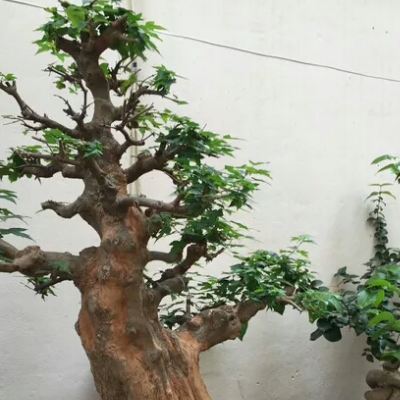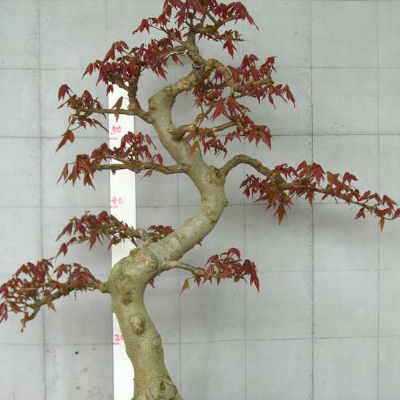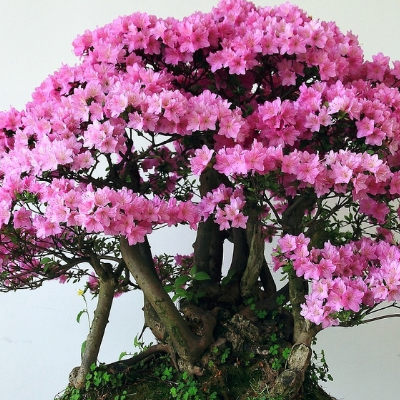How to trim the triangular maple bonsai? what's the price?
Triangular maple, this kind of tree can grow very tall, grow very good-looking, triangular maple bonsai how to trim? What is the price of triangular maple bonsai:

How to trim the triangular maple bonsai:
Under normal circumstances, the branches of the triangular maple will be about one meter long in late May, and the branches will be fixed in shape at this time, because the growth rate of the triangular maple itself is relatively fast, so its branches will grow straight upwards, so it is necessary to use manual work to pull the branches to the ideal angle. In the rainy season, the new branches will grow to about one centimeter, so they should be fixed in order not to be blown off by the strong wind and heavy rain. At the same time, prune the useless branches so that all the nutrients will be concentrated on the needed branches. When pruning, you must pay attention to the trunk or pay attention to the places where the whole body is easy to sprout, trim and cut frequently, so as to maintain the shape of the tree.
The price of triangular maple bonsai:
Triangular maple bonsai does have a certain collection value, it is based on the survival time of triangular maple, trunk stout, wood quality and other factors to judge, better triangular maple bonsai can be auctioned to tens of thousands of yuan.
The pruning method and price of triangular maple bonsai are introduced here, so hurry up to have one in your own home.
The necessary knowledge of triangle maple price summary and purchase
Introduction: the branches and leaves of Acer truncatum are dense, the shade covers the ground in summer, and the color of autumn leaves becomes dark red and delicious. It is suitable for solitary planting and cluster planting as shade trees, and can also be used as street trees and bank protection trees. It is suitable for planting on the shores of lakes, streams, valleys, lawns, or dotted with pavilions and rocks. Its old piles are often made into bonsai, and the trunk is twisted and raised, which is quite strange. In addition, there are people planted as green hedges in the south of the Yangtze River. After a long time, the branches split thorns and connect closely together, which also has a unique flavor. Home decoration to a basin, feel instantly tall on a lot of it, come and the rabbit to have a look, how much is the triangle maple?
Know triangular maple, alias: triangular maple, Latin name: Acer buergerianum Miq. Deciduous trees of the order Aceraceae and Acer, having brown or dark brown bark, rough lobes extending forward, entire or irregularly serrate. The fruit core protrudes and the fruit wing spreads into an acute angle. Like light, slightly resistant to shade, like warm and humid climate, slightly resistant to cold, more resistant to water and humidity, resistant to pruning. Autumn leaves are dark red or orange. It is grown in the middle and lower reaches of the Yangtze River in China and cultivated in the Yellow River basin. It is suitable to be used as shade tree, street tree and bank protection tree. It can also be planted as a hedge.
The price of triangular maple is elegant with beautiful dry skin, yellow-green flowers in spring and red leaves in autumn. it is a good landscaping tree species and foliage tree species. It is more suitable to be used as street or shade tree and lawn embellishment.
The price of Acer triangulata plant is generally 5 cm-30 yuan in diameter, 8 cm-150 yuan in diameter, 10 cm-250 yuan in diameter, 15 cm-500 yuan in diameter, 20 cm-850 yuan in diameter, 25-1200 yuan in diameter, 30 cm in diameter-1800 yuan, 35 cm in diameter-3500 yuan, 40 cm in diameter-6000 yuan, 50 cm in diameter-8000 yuan.
The price of triangular maple bonsai is 3400 yuan per tree in 20-22 cm, 4500 yuan in 24-28 cm, 6500 yuan in 29-33 cm, 9000 yuan in 34-36 cm, 13000 yuan in 40 cm and 18000 yuan in 50 cm. The specific price is determined according to the specific tree shape.
Spending so much money on triangular maple, how to manage it is of course very important.
Pot maintenance of Triangulum maple
(1) place: Acer truncatum likes sufficient light, so it is cultivated in the sunny place. We should pay attention to shading during the high temperature period in summer and move indoors in winter.
(2) watering: Triangle maple likes flooding, so always keep the basin soil moist. After the beginning of autumn, the leaves can be slightly dry when they turn red.
(3) fertilization: Acer truncatum grows rapidly, so it needs a large amount of fertilizer. In the spring and summer growing season, thin cake fertilizer can be applied every half a month, and appropriate phosphorus and potassium fertilizer can be added to make the autumn leaves gorgeous.
(4) turning the basin: the best time to change the basin is from February to March every spring. Acer truncatum has well-developed root system and rapid growth, and the basin can be changed once a year.
A good pot of potted plants, a good management, ensure that your family is superior. It is said that the leaves of the tree change from green to pink, purple or red and green in winter, and then turn to green in the spring of next year. People call it a "treasure tree". Do those who want to start have a plan in mind? go and report a shade tree home and experience the shade under it.
Introduction to the price and management method of tree stump bonsai
With people's living standards getting better and better, many friends have the conditions to cultivate their own hobbies, and many of them have hobbies that like growing flowers. And there are a lot of flowers and plants at home, and some friends have bonsai at home. Now what everyone likes most is the bonsai tree stump, which is not only beautiful, but also has a very good effect on purifying the air. But many friends are not very familiar with the tree stump bonsai, so the editor will share the knowledge about the tree stump bonsai in detail. I hope our sharing will be helpful to you.
Price of bonsai with tree stump
Tree stump bonsai is referred to as pile landscape for short, and its English name is tree bonsai. It's a kind of bonsai. Often use woody plants as production materials, rocks, figures, birds and animals as foil, through flat tie, pruning, shaping and other methods for long-term artistic processing and horticultural cultivation, in the bowl to show the wild giant trees lush tree scene, collectively known as tree stump bonsai. The plants with graceful posture, short plant, compact leaf shape, long life, pruning resistance, strong resistance and easy modeling are selected to restrain their growth and carry out modeling processing without violating the growth habits of trees. Tree stump bonsai can be divided into straight dry type, horizontal dry type, oblique dry type and so on. There are as many as 7 kinds of species. The general stump bonsai is 2000 yuan per plant (price source, for reference only).
Species characteristics of tree stump bonsai
According to the types and characteristics of the number used, as well as the characteristics of design and production, the tree stump bonsai can be divided into straight dry type, horizontal dry type, oblique dry type, curved dry type, cliff type, stone-attached type, hanging branch type and so on.
Straight trunk: the trunk is upright or basically upright, this kind of trunk allows it to grow to a certain height to pick the heart, to achieve a hierarchical, dense effect, usually divided into single trunk, double trunk, three trunk and multi-trunk.
Horizontal dry type: the trunk lies recumbent, the whole plant is sleeping, unique posture, with a simple and elegant demeanor.
Oblique dry type: the trunk is tilted, but does not lie down, the crown is on one side, and the tree is stretched. The sparse shadow of the common plum pile is oblique.
Curved stem type: the trunk is buckled and the tree shape is changeable. The common form is "Sanqu", which is shaped like the word "Zhi".
Cliff type: the trunk tilts out of the basin, and the crown hangs like a suspension. According to the degree of overhanging of the trunk, there are big cliffs, small cliffs and semi-cliffs.
Stone attachment: a lithophyte in which trees are planted on a stone and tied to a crack in the stone to imitate it.
Weeping branch type: suitable for tree species with many and long branches, such as Yingchun, weeping willow, weeping peach, etc., using their naturally drooping branches for proper processing.
Management method of tree stump bonsai
Watering method
Watering is one of the most important and frequent measures in the management of tree stump bonsai. The stump is planted in the basin, whether it is a deep basin or a shallow basin, the soil is always limited, and the water content is also limited. if the stump is not watered for a long time, the stump will wither due to lack of water, so it is necessary to observe in time and water according to the dry and wet condition of the soil to maintain soil moisture. Of course, overwatering can not be excessive, if overwatering, the basin soil is too wet for a long time, it is easy to cause root hypoxia and decay; at the same time, the amount of watering depends on specific tree species, seasonal changes, and warm and cold weather. Generally speaking, in summer or drought, it is best to water once in the morning and evening, every day or every other day in spring and autumn, the stump germinates in spring, and it can also be watered in the morning and evening according to the situation. During the rainy season or rainy days, there is no need for watering, but also pay attention to drainage. Sandy soil can be watered more, clayey soil should be watered less. Watering can be foliar spray, can also be root irrigation, generally a combination of the two, first foliar spray, and then root irrigation through, pay attention not to irrigate "half of the water" to cause basin surface wet, basin dry phenomenon, and leaf spray can not be too much, easy to cause branches and leaves to grow.
Fertilizer application
The soil in the pot of tree stump bonsai is limited, so the nutrients are also limited, so we should pay attention to the supplement of fertilizer. Because of its artistic characteristics, tree stump bonsai should not be fertilized too much or too frequently. It is necessary to master the content and types of fertilization and grasp the fertilization season. The three elements of plant growth nutrients are nitrogen, phosphorus and potassium fertilizer, nitrogen fertilizer can promote the growth of branches and leaves, phosphorus fertilizer can promote the formation of flowers and fruits, and potassium fertilizer can promote the growth of stem and root. therefore, the selection of fertilizer should be determined according to the type of tree stump and its growth trend. If you need to make the stump flourish, you can apply more nitrogen fertilizer; if you need more flowers and fruits, you can increase the content of phosphate fertilizer; when you need strong roots, you can apply more potash fertilizer. Fertilization methods are generally divided into late fertilization and quick fertilization. Delayed fertilization generally mixes organic fertilizer into the soil according to a certain proportion after crushing and maturing, and when changing soil, it is mixed into the basin to slowly provide nutrients; quick-acting fertilization is to dilute organic fertilizer or chemical fertilizer. Fertilization is carried out according to the seasonal growth needs of tree stumps, but it should not be too thick, newly planted tree stumps should not be fertilized in rainy days, fertilizer efficiency is lost, and the effect is not good.
Turn the basin and change the soil
After the growth of the stump bonsai for a period of time, the root system is covered with potted soil, crisscross, so that the ability to absorb fertilizer and water is weakened. at the same time, the nutrient elements in the potted soil are less and less, which is disadvantageous to the growth of the stump, so it is necessary to turn the pot and change the soil.
Turning the basin usually takes place in September in autumn or during the period from early spring to Qingming Festival. Tree species with fast root growth, such as pomegranate and Acer truncatum, turn their pots I times every 12 years, while slower-growing tree species, such as pines and cypresses, can turn pots once every 3-4 years.
The raw materials of basin soil are generally made of rotten leaf soil, which can be made from mountain mud, garden soil and fallen leaves. The specific approach is: after the fallen leaves of the trees in late autumn, dig a hole I meters deep in the open and convenient place, pile up the fallen leaves and mountain mud or garden soil layer by layer, and pour some people's feces and urine. The pile is 20 cm high and sealed with mud around to ferment it. Turn the pile for I times in about 1 month, and the leaves rot after 3 months, which can be sifted and used as basin soil.
The above is the knowledge about bonsai of tree stump that the editor has shared with you in detail. Friends who like bonsai planting should know more about bonsai. Bonsai stumps often use trees, birds and rocks as foil bonsai. Tree stump bonsai is not only cold-resistant, but also very resistant to shear, so it is easy to maintain. The posture of the stump bonsai is also very majestic, and there are many kinds, the most common of which are oblique dry type and horizontal dry type. The above knowledge sharing of tree stump bonsai is also very detailed. I hope that friends who are interested in tree stump bonsai can pay more attention to our sharing content.
- Prev

How to shape and raise the triangular maple bonsai
Triangular maple, this is a kind of tree, generally ornamental, can grow tall, triangular maple can also be made into bonsai, triangular maple bonsai how to shape? How to raise the triangular maple bonsai: how to shape the triangular maple bonsai: generally, it is better to design in the growing season.
- Next

What is the method of making indoor bonsai to put feng shui?
Indoor bonsai, this is a lot of people are in breeding, there is a shape of plants is so good-looking, indoor bonsai production method is what? What is the fengshui of indoor bonsai: how to make indoor bonsai: (1) prepare evergreen plants, fish tanks, stones and soil that need to be planted.
Related
- Fuxing push coffee new agricultural production and marketing class: lack of small-scale processing plants
- Jujube rice field leisure farm deep ploughing Yilan for five years to create a space for organic food and play
- Nongyu Farm-A trial of organic papaya for brave women with advanced technology
- Four points for attention in the prevention and control of diseases and insect pests of edible fungi
- How to add nutrient solution to Edible Fungi
- Is there any good way to control edible fungus mites?
- Open Inoculation Technology of Edible Fungi
- Is there any clever way to use fertilizer for edible fungus in winter?
- What agents are used to kill the pathogens of edible fungi in the mushroom shed?
- Rapid drying of Edible Fungi

